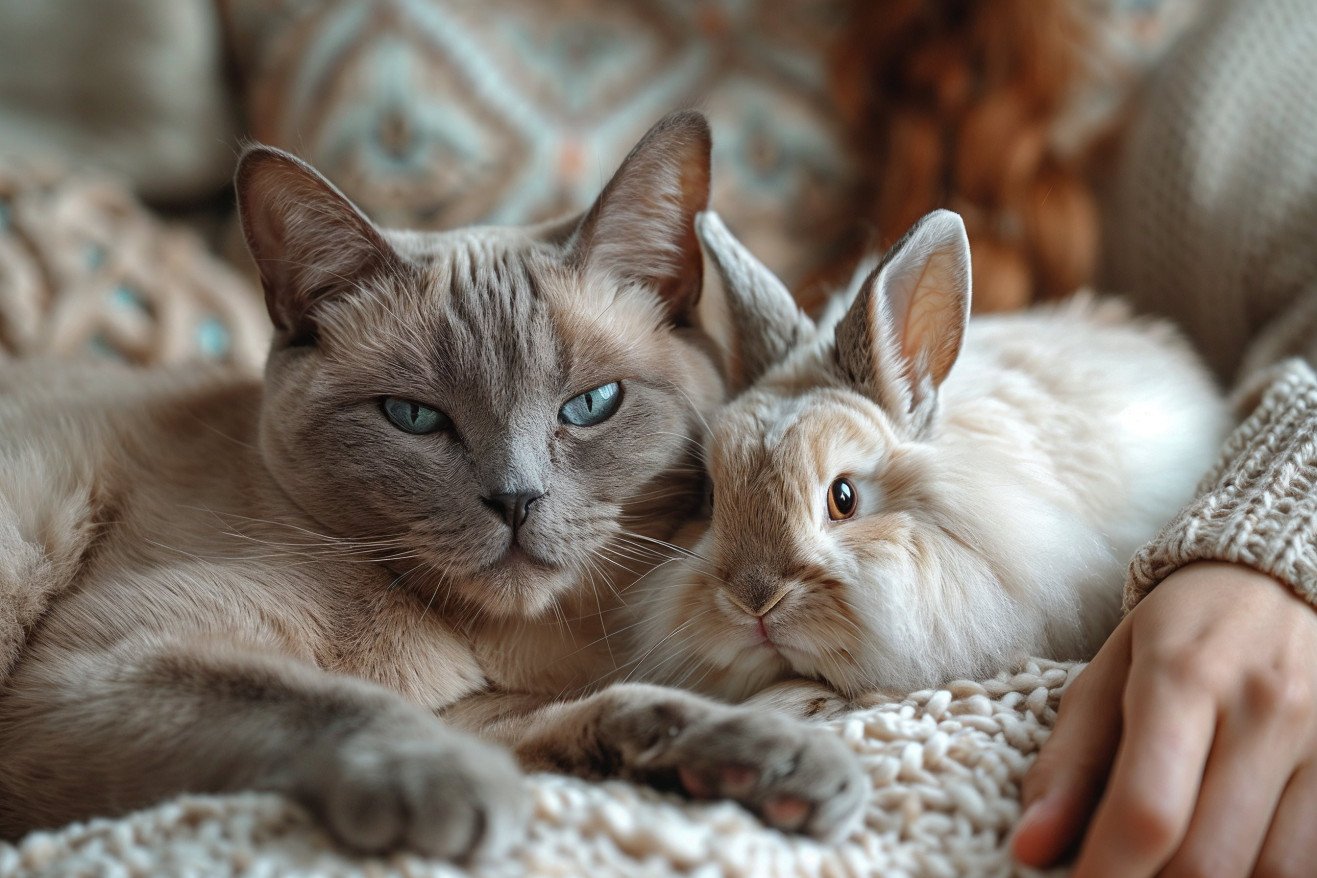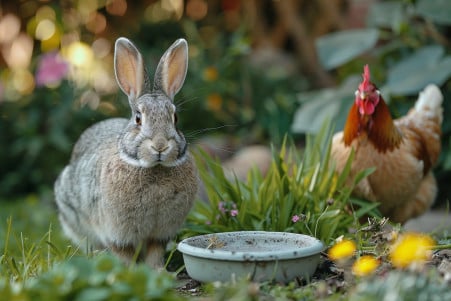Can Cats and Rabbits Live Together? Overcoming the Predator-Prey Relationship
7 May 2024 • Updated 6 May 2024

Although cats and rabbits can live together, the science shows that it can be difficult and that certain precautions must be taken to ensure the two animals can safely interact. Cats and rabbits have different personalities, behaviors, and dietary requirements, and their interactions will need to be closely monitored when they are first introduced and throughout their time together to ensure that the cat doesn't see the rabbit as a prey animal and attack it. However, with the right precautions, it is possible to help the two animals learn to live together.
This article will review the many studies that have been done on the predator-prey relationship between cats and rabbits and the ways that this relationship can be overcome. We will also look at veterinary and behavioral studies that offer insight into whether or not the two animals can be kept in the same home. From changes to the animals' environment to desensitization exercises, this article will help you understand how to help these two animals form a positive relationship.
Can cats and rabbits live together?
How to Introduce Cats and Rabbits
Introducing cats and rabbits to each other requires a lot of patience and a careful, step-by-step approach. According to Home & Roost, the introduction process should be slow and take place over a period of time, allowing both animals to become familiar with each other's scents, sounds, and movements. It's also important to ensure that both animals have access to their own separate spaces where they can feel safe and secure during the initial introduction period, as noted by The Brook Vet.
All interactions should be supervised, and the cat should be kept on a leash or behind a baby gate during the initial introduction period, according to Animal Friends, Inc. Positive reinforcement is also important, and both animals should be rewarded for calm, non-aggressive behavior during their interactions, according to Home & Roost. Scent familiarization can also be helpful, and you can help your cat and rabbit become familiar with each other's scents by swapping their blankets between their living spaces, according to HSNT.
The bottom line is that it's important to take things slowly, watch for signs of stress, and work to create positive associations between your cat and rabbit using treats and praise. With time and patience, it may be possible to overcome the natural prey-predator relationship between cats and rabbits, which will set the stage for the next phase of the process—creating a safe, stimulating environment in which both animals can live harmoniously.
Setting Up a Safe, Stimulating Space
Even after successful introductions, it's important to keep the cat and rabbit in separate living quarters, as Rabbit.org points out. The rabbit's living area should be large enough to move around in, with separate spaces for sleeping, eating, and using the litter box, according to VetCare Pet Hospital.
To make sure the rabbit's psychological needs are met, the space should also be enriched with toys, hiding spots, and things to chew and dig, says the Animal Humane Society. In addition, the rabbit's living area should be cat-proofed, with any cords or wires covered and the enclosure made of heavy-duty materials that the cat can't knock over, according to the Merck Veterinary Manual.
Creating one or more neutral spaces where the cat and rabbit can interact under supervision while maintaining their own territories can also help ensure that the two animals can coexist without conflict, according to Rabbit Awareness Week. If you take the right precautions and set up the right environment, the cat and rabbit may be able to interact under supervision without putting the rabbit's safety and well-being at risk.
Potential Dangers and Behavioral Issues
Even with the above safety measures, there are still risks associated with keeping cats and rabbits together because of their natural predator-prey relationship. As Berry Patch Farms explains, cats can accidentally hurt or kill rabbits through rough play, scratching, or biting. Cats can also cause rabbits to become extremely stressed and fearful, which can lead to health problems like gastrointestinal stasis, according to Catster.
Aggression from either animal, whether it's territorial or prey-related, can lead to dangerous situations. Rabbit.org notes that a cat or dog with a high prey drive that's separated from a pet rabbit is a very high risk situation, because a rabbit can be killed in a split second. Owners should also watch for signs of stress, such as excessive grooming, hiding, loss of appetite, or thumping.
Although some cats and rabbits can live together successfully with the right precautions, the research shows that there are many obstacles and dangers to overcome. As a result, many pet parents may feel that the risks of keeping cats and rabbits together are too great and opt to find another animal companion that's a better fit for their home.
Other Pet Options
For some cat or rabbit owners, the potential benefits of keeping the two species together may not outweigh the risks. While Cooper Pet Care notes that guinea pigs, ferrets, and certain dog breeds can be compatible with cats with the right introductions and supervision, rodents like rats, mice, and hamsters are generally discouraged because their small size can trigger a cat's hunting instinct, according to Cati in a Flat.
Birds and reptiles are also discouraged as potential cat companions for safety reasons, according to World's Best Cat Litter. It's important to remember to consider the unique personalities and compatibility of all animals when adding any new pet to your home, says Cooper Pet Care. With the right care and introductions, some other pets may be able to live in harmony with cats. However, the safety and happiness of all animals involved should always come first.
What It Means to Own a Rabbit
Rabbits have a number of care needs that must be met in order to ensure their health and happiness as pets. For example, VetCare Pet Hospital explains that their enclosures should be large enough to allow for exercise and have separate areas for sleeping and litter boxes. Meanwhile, Animal Humane Society recommends that the enclosure be enriched with toys, hiding spots, and materials for digging and chewing in order to meet the rabbit's behavioral needs.
In terms of diet, VetCare Pet Hospital says that rabbits should be fed unlimited grass hay, supplemented with fresh vegetables and a small amount of pellets. However, there are also a number of foods that rabbits should not eat, including beans, bread, and chocolate.
Rabbits are also social animals and should be kept with a bonded rabbit companion. They also need daily interaction and playtime, according to Merck Veterinary Manual.
In addition to spaying/neutering and other preventative measures, rabbits need regular veterinary care to stay healthy, according to Animal Welfare Victoria. While rabbits can make great pets when given the right care and attention, it's important to remember that they require a lot of time and effort, and this should be taken into account before deciding to get one.
Conclusion: A Delicate Balance
Cats and rabbits can live together successfully, but it takes a lot of work and careful planning. Their predator-prey relationship means that there are built-in dangers that owners will need to be mindful of. It's important to make sure that you introduce them properly, keep them in separate areas, and always supervise their time together.
Even with all of these precautions in place, there's still a chance that they will fight or hurt each other, so owners need to be prepared to separate them if necessary. Because of this, many people may find that it's not worth the effort to house cats and rabbits together and may want to consider other pets.


